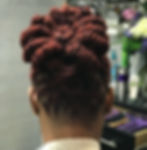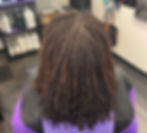Differences Between Traditional Locs, Microlocs, and Sisterlocks / Brotherlocks
- Stephanie Nightingale
- Jun 24
- 4 min read
Choosing the right hairstyle can be a challenging decision, especially when considering the variety of options available in the world of locs. Among the most popular choices are traditional locs, microlocs, and sisterlocks. Each style has its own unique characteristics, maintenance requirements, and cultural significance. This blog post will explore these distinctions to help you make an informed decision about which loc style fits your hair type and lifestyle best.
Understanding Traditional Locs
Traditional locs, often simply referred to as "locs," are perhaps the most recognized form of this hairstyle. They are typically larger and can be created through several methods, such as twisting, braiding, or freeforming. Traditional locs can take several months to form and mature, especially if they are started with loose hair.
One of the most appealing aspects of traditional locs is their versatility. They can be styled in various ways, including updos, ponytails, or left to hang freely. Maintenance usually involves regular shampooing and retwisting or palm rolling to keep the roots neat.
In terms of cultural significance, traditional locs have deep roots in various cultures around the world, often representing identity, spiritual beliefs, or a connection to heritage. They are an empowering style for many, allowing individuals to express their uniqueness and connection to their history.

Exploring Microlocs
Microlocs are smaller, thinner, and often created using a technique similar to traditional locs but with more precision. This style can be particularly appealing for those who want the look of locs without the bulk. The formation of microlocs can be done using methods such as interlocking, braiding or two-strand twists.
One significant advantage of microlocs is their lower maintenance and quicker drying time compared to traditional locs. Since they are smaller, they can also be styled in more intricate ways, similar to loose natural hair. However, they still require regular upkeep, such as shampooing and regular retightening.
The micro-sized locs allow for personalization and can cater to various hair types—making them a versatile option. They have gained popularity as people appreciate the delicate, refined aesthetic they offer while still embracing the loc lifestyle.

Delving into Sisterlocks/Brotherlocks
Sisterlocks / Brotherlocks are a specific brand of locs that adhere to a particular method of installation, using a patented technique. They are known for being uniform in size and shape, resulting in a distinctive and polished appearance. Sisterlocks can also be more intricate than traditional locs and microlocs, offering even more styling versatility.
The installation process of sisterlocks / brotherlocks is time-consuming and requires a trained professional. The technique involves the use of a special tool to create each loc, impacting how they form and mature. While this process can take several hours, the results often justify the time spent, yielding a highly defined look.
In terms of maintenance, sisterlocks typically require more frequent retightening every 4 to 6 weeks. This may appeal to those who are committed to the style, as it helps maintain the neatness and structure of each lock.

Comparing Maintenance Requirements
When it comes to choosing between traditional locs, microlocs, and sisterlocks, one key consideration is the maintenance requirements associated with each style.
Traditional Locs Maintenance
Frequency: Every 4 to 6 weeks for retwisting.
Products: Typically, natural oils and gels are preferred to avoid buildup.
Washing: Every 7 to 10 days of shampooing is essential, but care must be taken to ensure locs dry thoroughly.
Microlocs Maintenance
Frequency: Every 4 to 6 weeks for retightening.
Products: Lightweight styling products that do not weigh down the hair.
Washing: Every 5 to 7 days of shampooing is essential, as smaller locs can accumulate dirt more quickly.
Sisterlocks Maintenance
Frequency: Every 4 to 6 weeks for retightening.
Products: Sisterlock-specific products are usually recommended.
Washing: Every 5 to 7 days of shampooing is essential to prevent buildup while maintaining the health of the locks.
Choosing the right maintenance routine based on your lifestyle—whether you prefer frequent upkeep or a more laid-back approach—can help determine the style that suits you best.
Suitability for Different Hair Types and Lifestyles
Understanding the suitability of each loc style for various hair types and lifestyles is crucial for making an informed decision.
Traditional Locs
Traditional locs work well with various hair textures, from coily to wavy. They are ideal for those who embrace a larger, bolder look. Individuals with thicker hair may find this style easier to manage and maintain.
Microlocs
Microlocs thrive on finer hair textures but can also work on coarser hair. They adapt to different hair types, making them a flexible option for those who desire a more low-maintenance yet still stylish look. Microlocs are suitable for people who lead busy lives but still want to embrace their natural hair.
Sisterlocks
Sisterlocks are best suited for those with a tight curl pattern, as they rely on the hair's natural texture for structure. This style requires a commitment to maintenance, making it ideal for those who are passionate about natural hair and enjoy the perks of beautifully defined locs.
Cultural Significance and Aesthetic Appeal
All three styles—traditional locs, microlocs, and sisterlocks—carry rich cultural significance, particularly within African diasporic communities. Locs symbolize heritage, resistance against societal norms regarding hair, and an embrace of natural beauty. Each style allows individuals to connect with their culture and express personal identity.
From an aesthetic standpoint, each style offers unique visual appeal. Traditional locs are bold and free-spirited, microlocs present a refined charm, while sisterlocks/brotherlocks boast a clean, uniform look. When choosing the right style, consider how it aligns with personal values, aesthetics, and lifestyle choices.
Making Your Choice
Ultimately, the choice between traditional locs, microlocs, and sisterlocks/brotherlocks should reflect your hair type, maintenance preferences, and cultural alignment. Here are some points to consider when making your decision:
Personal Commitment: Are you ready to invest time in maintenance?
Hair Type: What style is most compatible with your hair texture?
Lifestyle: Does your daily routine allow for frequent upkeep?
Cultural Connection: Which style resonates with your identity and heritage?
Taking the time to weigh these factors can lead to a satisfying choice that enhances your personal expression through hair.

Deciding on a loc hairstyle is a personal journey. Whether you choose traditional locs, microlocs, or sisterlocks, each style offers a unique way to celebrate individuality and culture. As you explore your options, remember to embrace the journey and enjoy the transformative experience of your chosen style.

